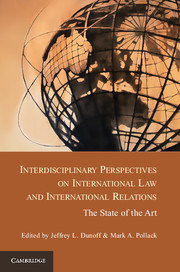 Interdisciplinary Perspectives on International Law and International Relations
Interdisciplinary Perspectives on International Law and International Relations Book contents
- Frontmatter
- Contents
- Contributors
- Acknowledgments
- Part I Introduction: Setting the Stage
- Part II Theorizing International Law
- 3 Institutionalism and International Law
- 4 Liberal Theories of International Law
- 5 Constructivism and International Law
- 6 Wanted – Dead or Alive
- Part III Making International Law
- Part IV The Interpretation and Application of International Law
- Part V Enforcement, Compliance, and Effectiveness
- Conclusions
- Index
- References
3 - Institutionalism and International Law
Published online by Cambridge University Press: 05 January 2013
- Frontmatter
- Contents
- Contributors
- Acknowledgments
- Part I Introduction: Setting the Stage
- Part II Theorizing International Law
- 3 Institutionalism and International Law
- 4 Liberal Theories of International Law
- 5 Constructivism and International Law
- 6 Wanted – Dead or Alive
- Part III Making International Law
- Part IV The Interpretation and Application of International Law
- Part V Enforcement, Compliance, and Effectiveness
- Conclusions
- Index
- References
Summary
In a major, theoretically oriented political science department in the mid-1990s, a young scholar proposed a dissertation topic that would focus on a detail of international law. In response, a very prominent international relations (IR) professor told the student that such a dissertation would probably yield no interviews, let alone any job offers. Such was the state of the discipline just a mere decade and a half ago – IR scholarship had “evolved” to the point at which international law was foreign! Although this advice went unheeded, it contained a profoundly important kernel of wisdom: if IR scholars were going to take international law (IL) seriously, they needed to be shown that a detail of international law could matter for something really important. Guess what? It turns out the details of international law matter for the things IR scholars care about: when and how international cooperation occurs and is maintained.
Contemporary international cooperation scholars for quite some time ignored international law. The early institutionalist literature, starting with and building on Krasner (1982) and Keohane (1984), still had to fight the uphill battle of whether international institutions matter, given the more fundamental debate over the possibility of cooperation. Prominent realists argued that concerns of states about relative gains and their position in the international system greatly inhibit the prospects for international cooperation (Grieco 1988; Mearsheimer 1994). The institutionalist literature, by contrast, emphasized the possibility to realize absolute gains from cooperation; that is, cooperation could be framed as a positive sum, rather than a zero sum, game. Keohane's After Hegemony (1984), for instance, takes Waltz's realist assumptions as a given and shows that cooperation can be maintained through international institutions even in the absence of a hegemon providing goods. Institutions, from this vantage point, facilitate and stabilize cooperation. In particular, institutions reduce transaction costs and provide an arena for regular communication, thereby fostering interdependencies and opportunities for (informational) exchange. And, by collecting and disseminating information, information asymmetries and uncertainties, often inherently hostile to cooperation, are resolved. These mechanisms help to maintain cooperation even in the adverse circumstances of an anarchic international environment.
- Type
- Chapter
- Information
- Interdisciplinary Perspectives on International Law and International RelationsThe State of the Art, pp. 59 - 82Publisher: Cambridge University PressPrint publication year: 2012
References
- 1
- Cited by


